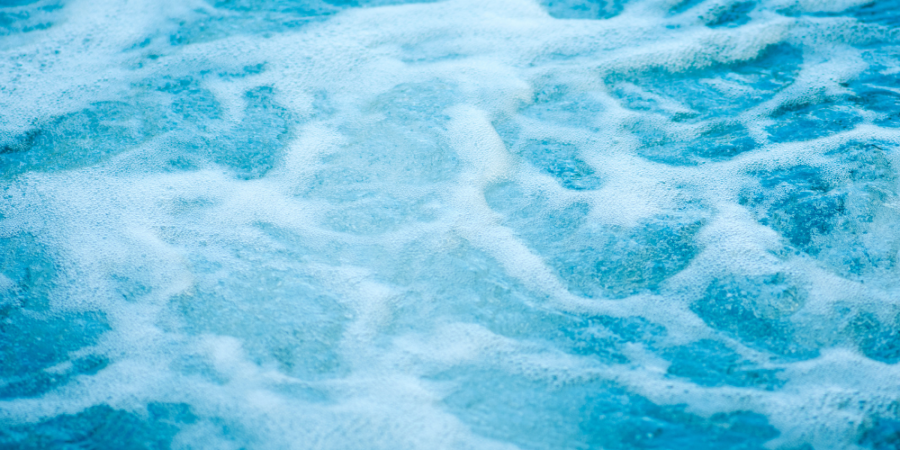Touchdown or Foam Touch
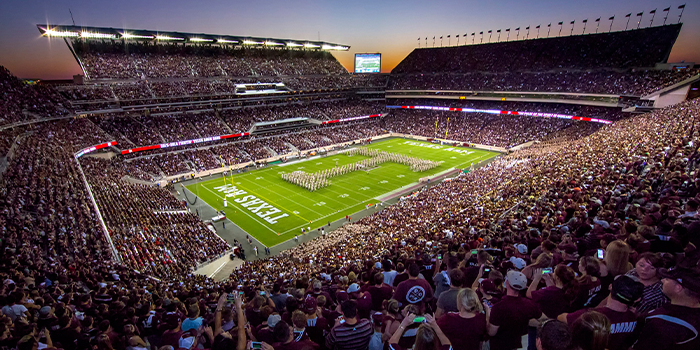

SPRAY FOAM MAGAZINE – The impressive structure of the Kyle Field American football stadium sits on the campus of Texas A&M University (TAMU) in College Station, Texas. It has been home to the Texas A&M Aggies football team since Spring 1905, with a permanent concrete stadium being constructed in 1927. TAMU has updated their stadium several times over the past 96 years and in two recent projects, SPF was applied to both Kyle Field’s new suites and their metal framed indoor training facility (ITF).
Dating back to the fourth century B.C., the ancient Greeks planned the first stadiums with a horseshoe design being the most prevalent. The Romans then expanded on this design by adding high rising seats. The objective of these early stadiums was to enable spectators to watch competitive sport in a place designed to honor the gods and state their power. It wasn’t until roughly 600 years later that this revolution in spectator gatherings was modified to bleachers and the oval shape stadium design which took shape in Europe purely for watching sport. The first American football stadium was built in 1895 for the University of Pennsylvania.
Just as impressive as those first groundbreaking designs is TAMU’s Kyle Field stadium. This bowl-shaped stadium has received numerous updates since 1904. Why was it built? Edwin Jackson Kyle, a graduate of Texas A&M and professor of horticulture, was also the president of the General Athletics Association. He wanted to develop an athletic field to encourage the school’s sports. However, Texas A&M was averse to delivering funds. In spring 1905 E.J. Kyle donated the field and built two sets of bleachers to accompany 500 people. It wasn’t until 1907 that the grandstands were purchased from Bryan fair association. Impressed with the outcome, the Texas A&M Board of Directors announced this area as a permanent athletic field, which served as the home for the football and baseball teams, and in 1927 the school chose to build a new concrete stadium.
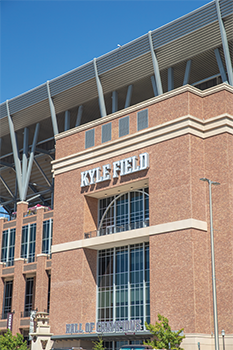
Fast forward to the final game of the 2022 season, a construction project was announced for the addition of 23 new suites to the south end of Kyle Field. The south end of Kyle Field was the last side of the stadium to have luxury suites added and they needed to be ready for the start of the 2023 Aggie Football season. Speaking at a press conference, A&M Director of Athletics Ross Bjork said, “Our goal is to ensure that Kyle Field, the ‘Home of the 12th Man,’ remains the pinnacle for college football stadiums.”
The architectural firm Populous worked on the Kyle Field Stadium 2023 redevelopment. These architects have a wealth of experience in stadium design, having been architects for the likes of Manchester City and Tottenham Hotspur football stadiums, to name just a few. They were also the lead architects for the Kyle Field Stadium project back in 2015 when they completed a project to amplify the noise level and intimidation factor on game days, with the field being lowered, and seating moved closer to the action. Canopies were also added to create a more comfortable, intimate, and to strengthen fan experience with the stadium’s four corners now filled with fans, in addition to new activation towers.
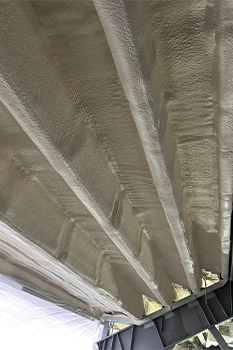
The General contractor for these projects was the Manhattan Construction Company, who has an impressive history in commercial buildings and venues. The reviewed seating capacity would be equal to 102,733 with 20,000 more fixed and bleacher seats than the original configuration. The renovated space also houses the Hall of Champions, a memorabilia space for Texas A&M Athletics.
These fast-tracked projects also required an insulation company that could work on a high-profile development and adapt to the logistics required to make sure the jobs were completed before game day commenced. With decades in the construction industry, and four years in the spray foam industry, InsCoat LLC Insulation and Coatings was the ideal company for such a demanding time limit. Based in Houston, Texas, this spray foam company has been in business since 2019. Brothers Ben and Jason Southard own the company, with Ben having a notable twenty-seven years in commercial drywall, having built many public buildings from schools to hospitals. Jason, Ben’s younger brother, was interested in getting into the construction business, so when Ben was looking for a partner, he chose a person he could trust, his brother.
Five years ago, Ben recognized the need to provide thermal scopes for commercial projects in their area. When it comes to insulation, Houston is an extremely competitive region, with several fiberglass insulation companies in the area. Ben and Jason chose to offer spray foam as an alternative solution. They bought a pneumatic rig, which Ben and Jason refer to as their ‘starter rig.’ The brothers quickly outgrew their starter rig and three years ago purchased their first Akurate Dynamics rig. They were so impressed with the system; they now operate four rigs. They particularly like the fact that this equipment reports and documents. Providing a complete history of on-ratio spray foam application to the client is, according to Ben, “extremely valuable especially when presenting this information to both a GC and architect. I personally believe their on-ratio system and close out documentation, that confirms that the manufacturers processing parameters were met, has led to our success story. Being able to provide our customers with written validation that we did our job right has garnered trust, repeat business, and helped us stand out in our market.”
InsCoat started their business by focusing on establishing business relationships with metal building general contractors. They also sprayed barndominiums using mainly closed-cell foam. During the height of COVID, they felt they could not actively sell closed-cell because it was so expensive and difficult to get hold of at the time. Therefore, they worked a lot with open-cell and consequently, now use both types of foam. They soon started insulating custom homes and for the last few years, have built a good following of custom home builders in Houston who are loyal to InsCoat. Ben and Jason have not forgotten where they started and still spray barndominiums and work on metal buildings every week.
In commercial projects, everything is specifications, and this is an area Ben thrives in. He has a thirst for all things building science, so learning and relaying knowledge about the spray foam industry has not only been beneficial for his company, but valuable when he discusses potential SPF projects with general contractors and architects. When he can, he loves to attend Lunch and Learns that many of the manufacturers and architect firms offer. “I love specifications and my entire career has revolved around operations and budgets and dealing with a lot of federally funded projects. I think people have not utilized spray foam as much as they could. You’ll hear more about the air conditioning side of energy efficiency, but many houses out there are under insulated and one of the ways to make a house more effective is to add an efficient insulation and not something that’s going to compress, like fiberglass,” Ben enthusiastically goes on to explain, “Building science is really a scientific guide on how to do things right in the industry. Making building envelopes better and tighter, whether that be a residential or commercial building, coupled with education, it’s paramount for the future of a healthy building.”
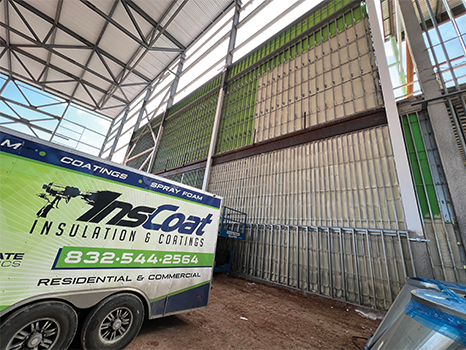
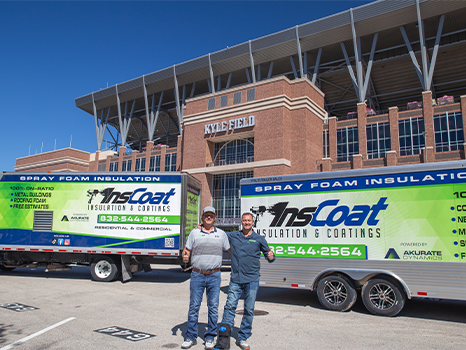
Jason Southard (left) and Ben Southard (right) in front of TAMU Kyle Field.
In addition to owning InsCoat LLC Insulation and Coatings, Ben is also the Director of Operations for a drywall company. Originally this drywall company had the contract for both the drywall and the acoustical ceiling design for the 110,000 sq. ft. TAMU IPF (indoor practice facility) project. The exterior wall insulation was originally specified for batt insulation, but the IPF’s façade was wide open, and the interior finishes needed to be completed. The architects needed to rethink the initial specified batt insulation. This required the general contractor (GC) to seek alternative insulation that could get wet during construction to help push the project forward with the approval of the Project Architect and Owner.
InsCoat attended a construction meeting for the project and the GC asked him what he could do to solve the insulation issue. “Use closed-cell foam in lieu of the batt insulation specified,” replied Ben. After discussing all the benefits of the foam, InsCoat went through a short submittal and change order process. Eight days later, they had the direction to install the spray foam. The building had a brick façade and inside the metal framed cavity space, the crew sprayed BASF’s SPRAYTITE closed-cell foam. They worked in double shifts for the project to gain the time back for what was an aggressive schedule. The InsCoat crew started spraying in June, with all other subcontractors having to have their work completed before the football practice kick off in early August.
Large commercial projects like the ones at TAMU, takes planning and logistics, and Ben thrives in these disciplines. Describing himself as a “behind the scenes guy,” he bids on the work, writes up proposals and negotiates the contracts. He essentially deals with all the financial aspects of the business. His brother Jason is a master installer through SPFA training and takes the lead on training new crew members. He also runs the field crew and the day-to-day operations on many of their projects. “Jason is excellent in the field, customer relations, and as the company is growing, he is helping on the bidding side of things too. We also have some great lead sprayers working on our projects.”
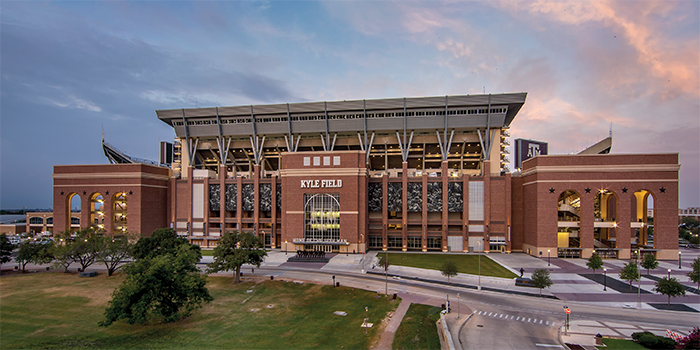
In addition to working on the TAMU IPF project, the InsCoat crew also worked on the adjacent TAMU Kyle Field project. The crew had just finished working on the IPF and the GC called Ben to the site to explain how another contractor they had hired to install K-13 insulation was two months behind and could not make the scheduling and could InsCoat apply SPF. The Kyle Field project included suite upgrades on the second floor with the grandstands above. “They were building air-conditioned suites and instead of applying the K-13 as originally specified, our crew sprayed two inches of closed-cell foam on the bottom side of the concrete grandstands bleachers to encapsulate the conditioned space. Both the IPF and the Kyle Field projects combined equaled 40 sets of foam.”
The crew at InsCoat is strict when it comes to wearing full PPE and using the correct safety equipment. Both the IPF and the Kyle Field suites required the use of numerous boom lifts, ranging from 80-100 ft. Safety harnesses were therefore double checked and used according to OSHA standards. Manhattan Construction had a strict written safety policy for the InsCoat crew and because SPF was a new insulation for this team, the safety manager would often check in on them.
Ben and Jason currently have eight team members working for them, plus the team at ADIM Media, a social media management company in Tomball, TX – all with the ambition for future growth. The crew of eight sprayed both tasks in nine days to help keep the project on track and made a couple of subsequent visits to the site to finish some minor work that wasn’t quite ready for them during that nine-day span.
The InsCoat crew had great feedback following both projects with both the architect and the GC being happy with the result and the fact that time was gained back into the timetable. During summers, young athletes are invited to Kyle Field for football training camps and in the fall, the stadium plays host to various Texas high school football playoff games. The updated IPF and the additional suites have enriched this prominent college stadium to equal that of a professional one. By adding superior materials, like spray foam, anything is possible and that really is a touchdown for all involved.
“This was a huge undertaking for our company. I feel proud of the way Jason and I handled the logistical pressure and the successful outcome of the project. My oldest son is transferring to TAMU’s Construction Science undergraduate department next year. It will be a satisfying moment to sit with him at this prestigious stadium knowing InsCoat had a part in its construction,” concluded Ben.
For use by SprayFoamMagazine.com & Spray Foam Magazine
Disqus website name not provided.






